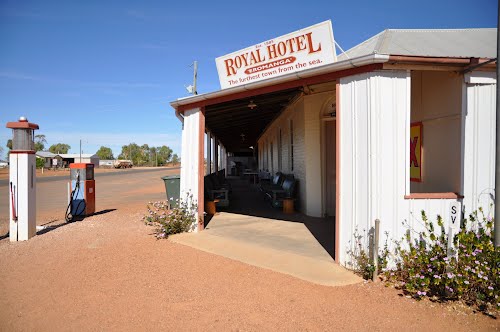 In 1871 the first Opal lease in Australia was registered south of Quilpie. Very little work was carried out on the 360 acre lease other than the sinking a couple of shallow shafts, and the lease was abandoned after several seasons. Twenty years later, the discovery of Duck Creek further south brought renewed interest in the area, the lease was re-pegged and named Pride of the Hills.
In 1871 the first Opal lease in Australia was registered south of Quilpie. Very little work was carried out on the 360 acre lease other than the sinking a couple of shallow shafts, and the lease was abandoned after several seasons. Twenty years later, the discovery of Duck Creek further south brought renewed interest in the area, the lease was re-pegged and named Pride of the Hills.
Toompine – The Paroo Fields, as they are known, lie east and south-east of Toompine Pub (77km S of Quilpie); Including the famous Pride of the Hills, Lushingtons, Coparella, Brodies Flat , Brodies Hill, are at the northern end of a run of mines heading south to Yowah.Then come Sheep Station Creek, Emu Creek and Duck Creek. Fiery Cross and Kyeenee are 30kms from Yowah.
Duck Creek is a small (≤1km²) gem Crystal Opal field (85km N of Yowah) discovered in 1891. Renowned for seam Opal of the highest quality, possesed of a brilliance surpassing that of almost all other crystal Opal on the Queensland fields.
Quilpie – West and north-west of Quilpie; The vast Quilpie Mining Area is home to several of the most productive Opal mines in history, the famously prolific Hayricks, Bull Creek and Pinkilla Mines are still operating today. The region is noted for producing considerable volumes of large boulders. These contain predominantly Light Boulder Opal which often runs into smaller amounts of Black Boulder Opal.
Bulgroo – Further north of Quilpie field in the Cheviot Range, the mines include Bulgroo (Germans) and still further north west Budgerigar and Trinidads.
 Yaraka
Yaraka – This field encompasses the mines within and west of the Macedon Range (165km W of Blackall): Including
Harlequin and the mighty
Mount Tighe. This area is other-worldly, looking out over the open country between the ridges from the mine at the highly uplifted top of Mount Tighe is truly an amazing view to behold.
Highlands (to the west), as the name suggests, is part of the same highly elevated opal country. Famous for top patterns and various types of opal in as many as 8 levels. Mines include
Spur,
Polykettle,
Cockatoo and
Pretty Gully.
 Eromanga –
Eromanga – “Farthest Town from the Sea” but just a hop and a skip to the
Scotchman and some ‘bloody ripper’, ‘you beaut’ Opals! Also the namesake of the Eromanga Sea, the great inland Sea, that once covered much of the forming continent and the outline of which hosts the vast Boulder Opal fields.
Numerous discoveries were made in the area from the mid 1870’s and the miners brought Cobb & Co. to Windorah helping to establish Eromanga. ‘Opalopolis’ as it became known, was essentially Australia’s first Opal mining town, with two hotels and a police station. However due to the sparsity of the surrounding deposits Eromanga was eclipsed and the monicker taken by Whitecliffs in a little under two decades.
By 1878 over 200 men were combing the ‘Kyabra’ hills to the west and Keerongooloo Station to the NW and until the collapse of the industry in 1912, with the advent of WWI, Eromanga was the headquarters for all visiting buyers many of whom travelled from as far abroad as Germany.
Visit Opalopolis park and see the monument to the Opal miners which is appropriately inlaid with local Boulder Opals. Quench your thirst at the Royal Hotel, whose mud and brick structure was one of the original buildings on the Cobb & Co. route having opened its doors in 1885.
Famous Mines include: Alladin, Breakfast Creek, Cunnavalla, Exhibition, Little Wonder, Friday Creek, Gem, Hammond’s, Seven Wonders, Scotchman, Stoney Creek, Top of the World, Quartpot…
In 1871 the first Opal lease in Australia was registered south of Quilpie. Very little work was carried out on the 360 acre lease other than the sinking a couple of shallow shafts, and the lease was abandoned after several seasons. Twenty years later, the discovery of Duck Creek further south brought renewed interest in the area, the lease was re-pegged and named Pride of the Hills.